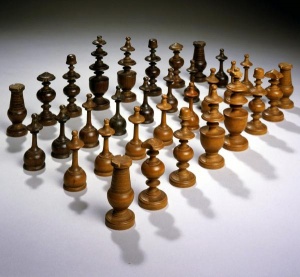To a small but dedicated group of followers, Arthur Conan Doyle’s Holmes and Watson stories are more than just great literature. They are part of what they call “the game,” in which Sherlockians maintain that Watson and Holmes were real, their adventures actually happened, and the stories were truly written by Watson with Conan Doyle serving as his literary agent. From this “gentle fiction,” as one author calls it, springs a wealth of writing of sometimes astounding imagination and wit, speculating on every detail of the stories and weaving elaborate theories to reconcile Conan Doyle’s sometimes dodgy dates and details. A massive new annotated set of the tales promises to reinvigorate the game for a whole new generation.
Leslie S. Klinger’s The New Annotated Sherlock Holmes (Norton, 2 vols., $75) takes a different approach from William S. Baring-Gould’s Annotated Sherlock Holmes, the two-volume set at the heart of every true Sherlockian book shelf (usually at the end of the shelf, propping up the rest of the books). Originally published in 1967, Baring-Gould’s massive work collects and annotates the 56 short stories and four novels, explaining obscure aspects of Victoriana and often elaborating on various hot-button Holmes-Watson issues, such as the marriages of Watson, Holmes’ missing years, and torrid speculations about Holmes’ relationship with Irene Adler (of “A Scandal in Bohemia”).
Though beloved by Sherlockians, Baring-Gould’s work (including his terrific mock biography, Sherlock Holmes of Baker Street) has long been a source of mild controversy for its chronological organization. Baring-Gould was dedicated to determining the order in which the adventures actually happened, and his placement of individual stories within the timeline has been hotly disputed among Sherlockians, who are capable of hotly (and quite amiably) disputing pretty much anything.
Hand Me My Gazetteer
As an indicator of exactly how much material Klinger had to work with, one need only look to The Complete Baker Street Journal on CD-ROM (available at www.bakerstreethournal.com for $100). Published since 1947, the BSJ is the main journal of Sherlockian scholarship, and its complete archives fill four CD-ROMs in PDF format, adding up to some 16,000 pages of material. Every issue of the BSJ is included, from its origins to the year 2000, accompanied by cumulative indices and searchable through the included Adobe Reader software. Aside from the usual news and records of meetings one would expect in a publication such as this, there are countless articles dissecting every aspect of the “canon,” or “sacred writings” as it is known to the Baker Street Irregulars.
For instance, in Scandal in Bohemia, Holmes refers to the landlady as Mrs. Turner, yet we all know the landlady is Mrs. Hudson. The answer is, of course, prosaic: in the manuscript of "The Empty House," Doyle made the same mistake, but crossed out "Turner" and wrote "Hudson." In "Scandal," however, he didn't catch the error. This is a feast for Sherlockians, who have speculated that it was actually Martha Turner (the second victim of Jack the Ripper); that Turner was an alias used by Mrs. Hudson during a tryst with Holmes in a country hotel or inn, and Holmes simply slipped by using this name; that it was a character from The Boscombe Valley Mystery; and so on.
The late pulp writer Manly Wade Wellman used the Holmes/Hudson affair for a delightful flight of fancy called “The Great Man’s Great Son: An Inquiry into the Most Private Life of Mr. Sherlock Holmes” (found on Disc 1, Volume 1, Number 3 of the BSJ on CD-ROM). Wellman lays out a detailed case to prove that the illicit love child of Holmes and Mrs. Hudson was none other than … Jeeves, Bertie Wooster’s redoubtable gentleman’s gentleman in the P.G. Wodehouse stories. By the time Wellman fills in all the lacunae, you begin to believe it. (Wodehouse himself idolized Conan Doyle, so the speculation would have no doubt amused him.)
Making these connections is all part of the game, and the BSJ archives are a treasure trove of material, with such Holmesian figures as Christopher Morley, Edgar Smith, and Vincent Starrett sharing space with notable writers such as Wellman, Robert Bloch, John Dickson Carr, and Ogden Nash. The BSJ is still a thriving publication with four issues plus a special Christmas annual each year, with subscriptions starting at $25.
The Game is a Footnote
Klinger has mined this treasure trove, much of it unavailable to Baring-Gould, for his New Annotated Sherlock Holmes. He dodges the chronological issue by organizing the 56 short stories according their order in the five collections Doyle published in his lifetime. (A third volume collecting and annotating the four novels is scheduled to appear in Spring 2005.) Though it will no doubt spare him many dissenting articles in the Baker Street Journal, it’s ultimately a less satisfying order than the Baring-Gould chronology (which links the tales into a flowing biography of Holmes and Watson) or even an arrangement by composition or publication (which would allow us to see Conan Doyle’s development as a writer).
Measured against the quality of the rest of Klinger’s work, however, this is a trifle. Klinger engages in the game with gusto. The new annotations and essays largely sidestep issues of mainstream literary criticism to integrate the last 30 years of Sherlockian scholarship, offering numerous alternate theories while elaborating on the lives and connections of peripheral characters. Was Moriarty a figment of Holmes’ imagination? Was Holmes replaced by an imposter after his death at Reichenbach Falls?
The notes also explain many details of Victorian life, helping to establish locations, explain slang, and place story aspects in their historical and cultural context. The book begins with a brisk but immensely informative introduction explaining the time and place of the stories and offering biographies of Doyle, Holmes, Watson. Both volumes are heavily illustrated with the original Strand drawings and period photographs, which prove quite useful when trying to visual a gasogene, for instance. Some of Baring-Gould’s annotations are carried forward intact, but much more is added.
On the other side of the aisle is the nine volumes of the complete Oxford Sherlock Holmes, which offers A Study in Scarlet, The Sign of Four, The Hound of the Baskervilles, The Valley of Fear, The Adventures of Sherlock Holmes, The Casebook of Sherlock Holmes, The Memoirs of Sherlock Holmes, and The Return of Sherlock Holmes. (Most of these titles are available in matching paperbacks for less than $10.) Each has a lengthy introduction about the background and writing of the world, with extensive endnotes dedicated to Conan Doyle’s sources as well as Victoriana. Frankly, most devoted fans will find the books nicely complimentary: Klinger focusing on the inner life of the stores, and the Oxford editions focusing on them as works of literature.
The Final Problems
And the Holmes industry continues to thrive. New books, novels, stories, and pastiches are published each year, creating a modest cottage industry dedicated to chronicling the adventures of the Holmes, Watson, and even peripheral characters from the series. Loren D. Estleman’s entertaining Sherlock Holmes vs Dracula: The Adventure of the Sanguinary Count and Dr. Jekyll and Mr. Holmes are back in print, and Laurie King recently published volume 6 of her critically acclaimed Mary Russell series. Beginning with The Beekeepers Apprentice (Holmes retired to the country to become a beekeeper in his later years), King’s series teams Holmes with a young American woman in a series of vastly entertaining mysteries. A quick Amazon search for “Sherlock Holmes” will yield a surprisingly wealth of new material ranging from pedestrian pastiches to polished fiction.
He continues to thrive in other media, as well. Over the past few years MPI Home Video issue a dozen of the original films starring Basil Rathbone and Nigel Bruce as Holmes and Watson, and the complete run of Grenada television series starring Jeremy Brett. Holmes even made his long awaited-return to computer games with the adventure “Secret of the Silver Earring” (see our review this issue).
This fall [2004] saw the publication of Sherlock Holmes: The Hidden Years, a terrific new hardcover anthology edited by Michael Kurland, author of a series of novels about Professor Moriarty and editor of the previous Holmes tribute My Sherlock Holmes. The Hidden Years recruits authors Peter Beagle, Carolyn Wheat, Richard Lupoff, Rhys Bowen, and others to fill in the gap of “The Great Hiatus,” the three years between Holmes alleged death at Reichenbach falls and his reappearance in “The Empty House.” Only one of these stories is a true pastiche (that is, a work written in the style of the original), while others use a variety of styles to challenge the great detective (sans his Boswell) in mysteries ranging from Tibet to San Francisco to New Orleans and beyond.
Conan Doyle’s work uniquely lends itself to this kind of lavish attention due to its wealth of detail, from place names to odd characters. The Sherlockians take mystery stories that are, in themselves, literary puzzles solved by a master, and apply his techniques of observation and deduction to tease interesting theories from the text. Had Doyle written more, or been more careful with some of his dates and characters, perhaps the game never would have evolved the way did.
Or perhaps not. The game began while the stories were still being written, with Andrew Lang’s 1904 “open letter to Dr. Watson” (published in Longman’s Magazine), analyzing the story “The Three Students.” Klinger cites Father Ronald Knox’s 1911 “Studies in the Literature of Sherlock Holmes” (written as a parody of Biblical scholarship) as the beginning of Holmes studies. Knox favored using a “method by which we treat as significant what the author did not mean to be significant, by which we single out as essential what the author regarded as incidental.” In this, he was merely following the dictum of the Master: “the little things are infinitely the most important.”
These “little things” continue to fascinate over a century after the original tales appeared. Indeed, can any other author lay claim to such a serious examination not of his work, but of the fictional life of his characters? As legendary Sherlockian Christopher Morley famously observed, “Never has so much been written by so many for so few.” Perhaps a book like The New Annotated Sherlock Holmes will prove that it’s not for so few after all.












